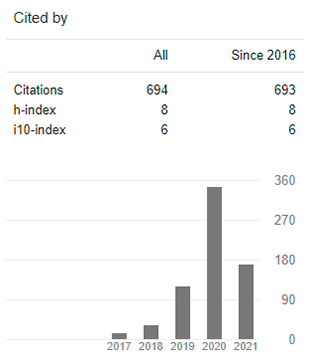Hearing Pollution due to Improper Use of Sound Equipment Bahía Buenaventura Urbanization
DOI:
https://doi.org/10.29394/Scientific.issn.2542-2987.2022.7.26.7.133-147Keywords:
noise pollution, sustainable development, pedagogical strategies, social environment, environmental impactAbstract
The noise pollution present in the Bahía Urbanization, located in the District of Buenaventura, is a problem that has traditionally been limiting the community located there, the ability to enjoy an adequate existence since the noise emitted by sound equipment turned on at high of urgency, cause contamination in the community environment, resulting in severe alterations in the people of the community who, involuntarily subjected to this negative situation, perceive themselves as being violated in different ways in their physical and mental health as well as in the environment. social of the neighborhood. The study consists of addressing the problem of noise pollution generated by the inappropriate use of sound equipment in the indicated community and for the development of the study, it was necessary to carry out a respective bibliographic review and application of investigative instruments in the field of study. in order to have the necessary elements that will lead to the analytical establishment. Conclusively, the investigation showed that musical noise is a condition that constantly affects families settled in the Bahía urbanization of the Buenaventura District, making this situation a fact that generates felt limitations for the adequate existence of people.
Downloads
References
Amable, I., Méndez, J., Méndez, J., Delgado, L., Acebo, F., Armas, J., & Rivero, M. (2017a,b). Contaminación ambiental por ruido. Revista Médica Electrónica, 39(3), 640-649, e-ISSN: 1684-1824. Cuba: Centro Provincial de Información de Ciencias Médicas.
Behar, D. (2008). Metodología de la Investigación. ISBN: 978-959-212-783-7. Colombia: Editorial Shalom.
Fernández, F. (2011). Estudio general de la contaminación acústica en las ciudades de Andalucía. Cuadernos Geográficos, 49, 55-93, e-ISSN: 2340-0129. España: Universidad de Granada.
García, X., García, I., & García, J. (2010). Los efectos de la contaminación acústica en la salud: conceptualizaciones del alumnado de Enseñanza Secundaria Obligatoria de Valencia. Didáctica de las Ciencias Experimentales y Sociales, (24), 123-137, e-ISSN: 0214-4379. Recuperado de: https://roderic.uv.es/handle/10550/21231
Gonzales, Y., & Fernández, Y. (2014). Efectos de la contaminación sónica sobre la salud de estudiantes y docentes, en centros escolares. Revista Cubana de Higiene y Epidemiología, 52(3), 402-410, e-ISSN: 1561-3003. Cuba: Centro Nacional de Información de Ciencias Médicas; Editorial Ciencias Médicas.
Perea, X., & Marín, E. (2014). Percepción del ruido por parte de habitantes del barrio gran limonar de la comuna 17 en la ciudad de Cali. Tesis. Santiago de Cali, Colombia: Universidad Del Valle. Recuperado de: http://hdl.handle.net/10893/7747
Solís, A. (2013). Influencia de la contaminación sonora en la salud pública del poblador del cercado de Lima. Paideia XXI, 3(4). 47-59, e-ISSN: 2519-5700. Perú: Universidad Ricardo Palma.
Downloads
Published
How to Cite
Issue
Section
License
Copyright (c) 2022 INDTEC, C.A.

This work is licensed under a Creative Commons Attribution-NonCommercial-ShareAlike 4.0 International License.
The content of the journals of this site, are under a Creative Commons Attribution-Noncommercial-Share Alike 4.0 International License.













